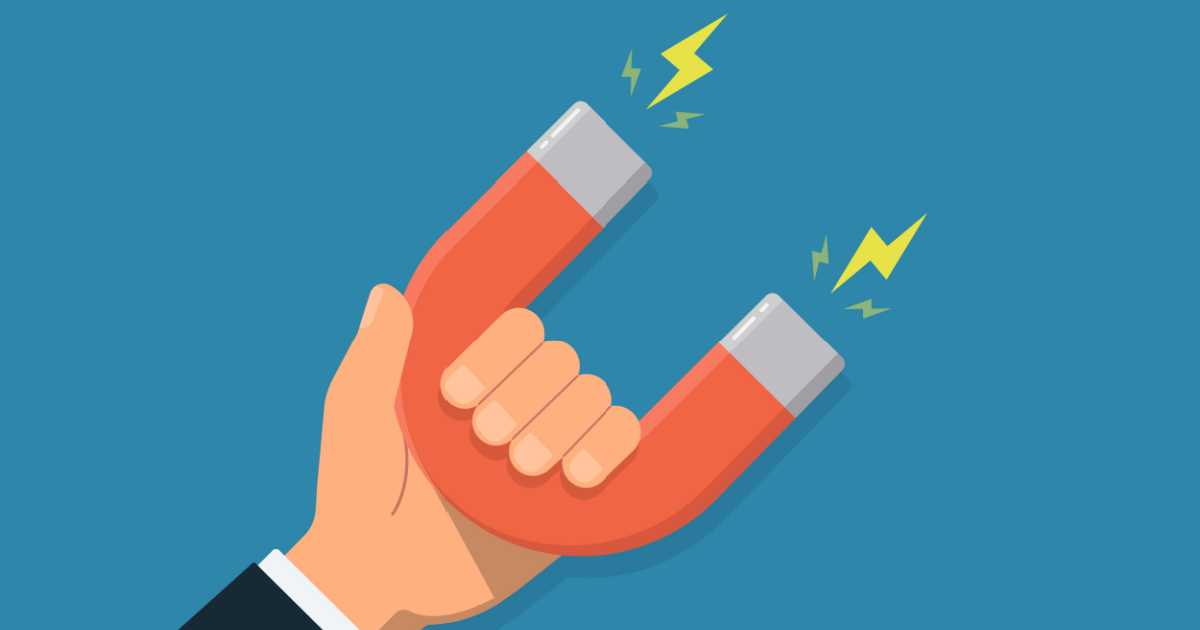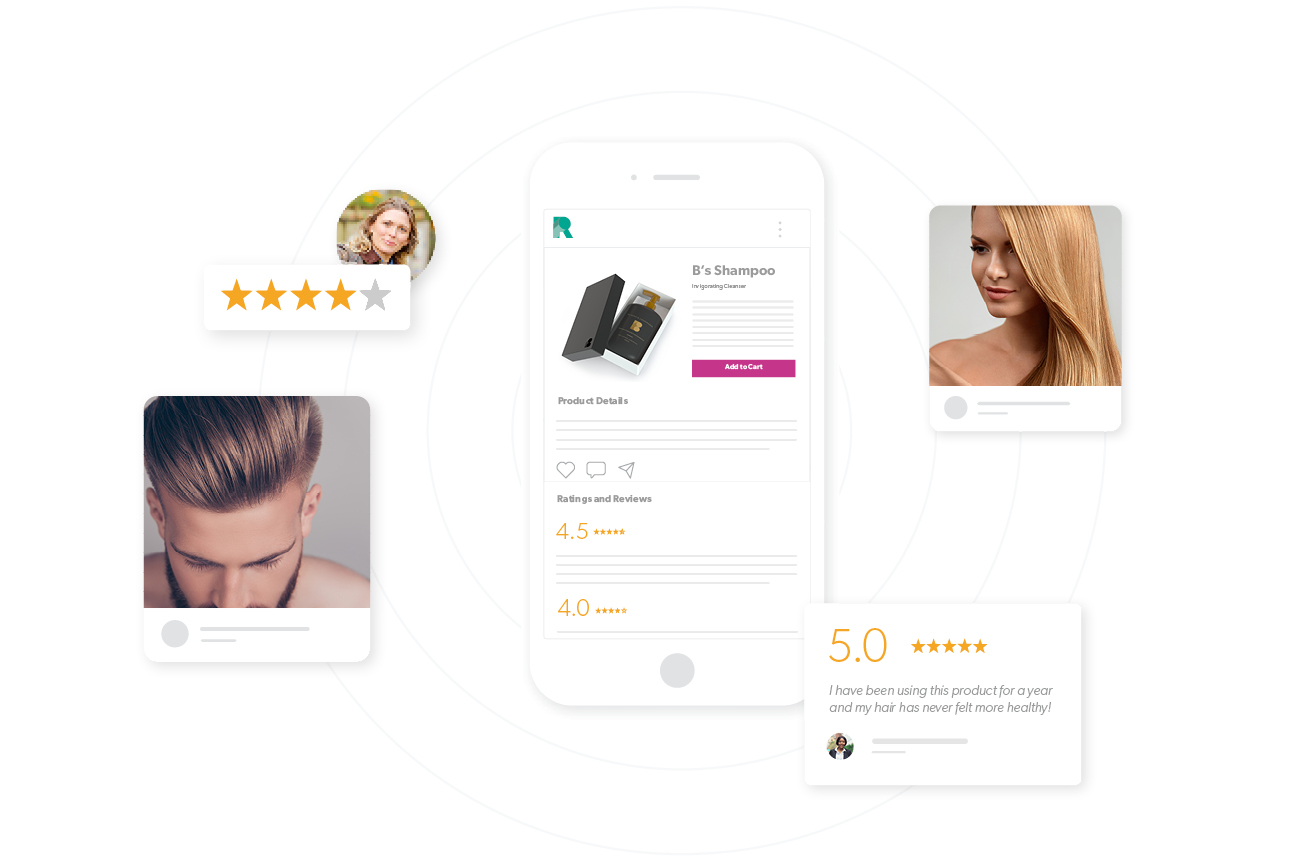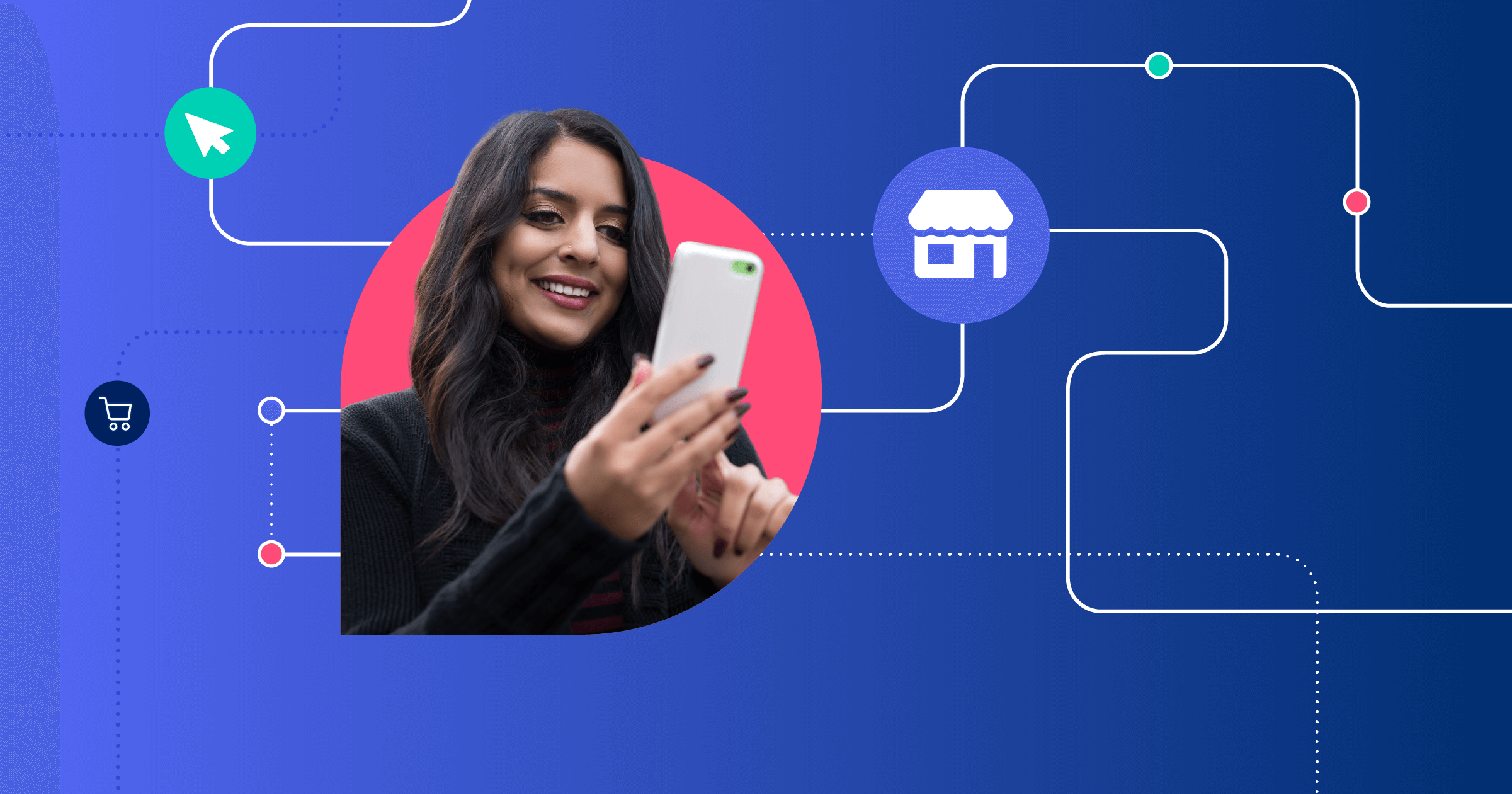December 5, 2022
The retail shelf is so 2019. With global e-commerce sales expected to increase by 50% by 2025, winning the digital shelf game is the top priority for brands. Or at least, it should be. E-commerce brands that optimize their digital shelf will stand out from their competitors, attract more customers, and generate more sales online and in-stores.
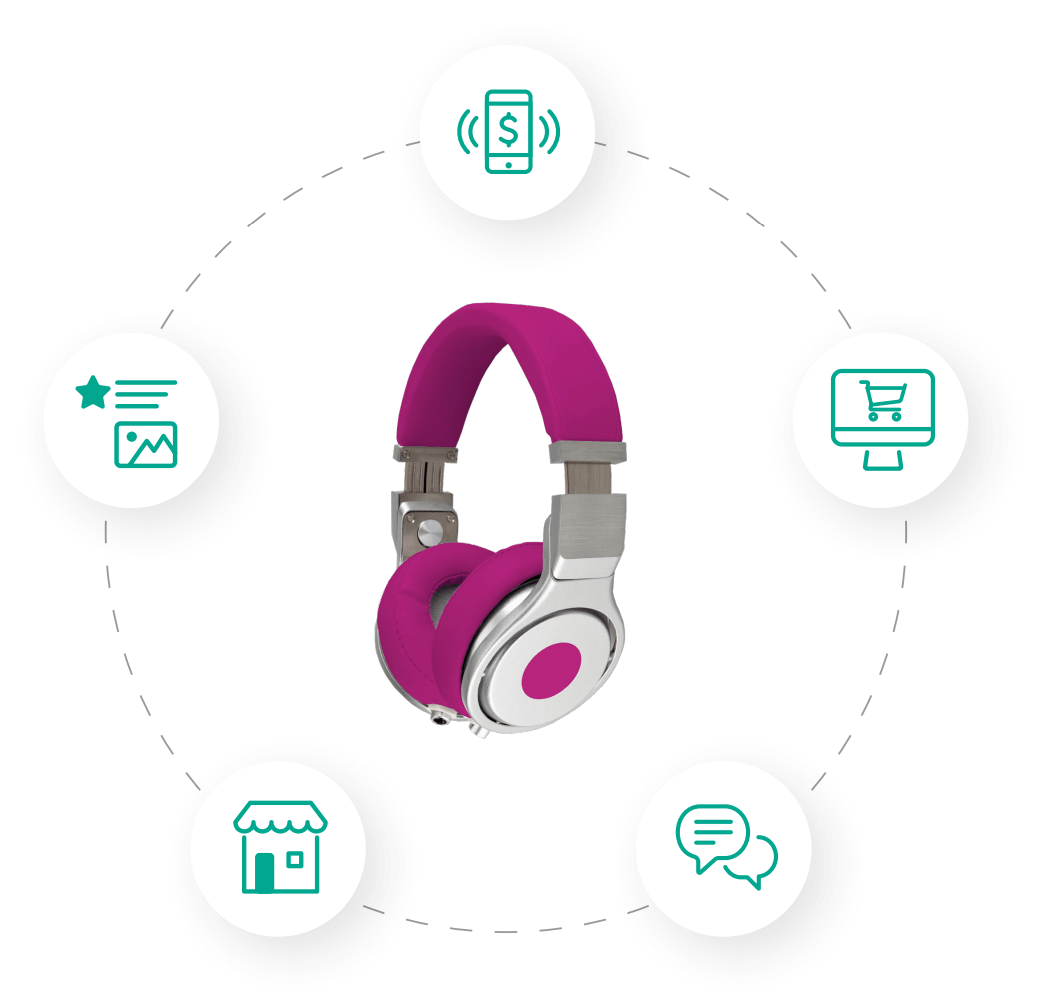
Chapters:
- What is the digital shelf?
- Why the digital shelf is key to attracting more customers
- Best practices for your digital shelf strategy
- Expand your brand’s digital shelf with user-generated content
Picture the glossy shelves at Sephora, showcasing lipsticks, eyeshadow palettes, face masks, perfumes, and hair accessories to entice shoppers as they browse the store. They’re typically grouped by product category, and brand displays feature essential product information. Plus customer favorites and suggested product bundles. When brands compete with each other in stores, they need to use the limited real estate of a retail shelf to get their customers’ attention fast.
The same applies to the digital shelf. Trade the well-lit displays at Sephora’s physical store for their sleek website design, where image carousels highlight best-selling products, gift sets, and special offers. The strategy is pretty much the same: capture consumers’ attention, teach them about the brand and its products, and convince them to make a purchase — and come back for more.
What is the digital shelf?
The digital shelf is the intersection of all the channels and touchpoints where people discover, learn, and buy from your brand online, that impacts in-store sales too. Rather than browsing store shelves, comparing similar products, and heading to the checkout lane, shoppers can use the digital shelf to complete the customer journey online.
It’s how people discover your brand online (and in-store)
When shoppers want to look for products online, they turn to the digital shelf to start browsing their options.
Consumers typically begin their online shopping journey with a simple search on Google or their preferred online retailer. But they’re also doing it on their phones while in-store as well. Like a store associate in a brick-and-mortar retail store, search engines direct consumers to what they’re looking for online. Whether someone is browsing a general product category or searching for something specific, the search results page will turn up a range of relevant products.
Other channels where consumers can find your products on the digital shelf include:
- Product pages and descriptions
- Social media
- Third-party marketplaces
Unlike the physical retail shelf, the digital shelf can be customized to each shopper’s needs. By analyzing customer data, you can deliver highly personalized marketing messages, like product recommendations and special offers, that are more likely to convert.
It’s how consumers research your products
After finding your brand, shoppers use the digital shelf to learn more by analyzing your products and comparing you and your competitors.
The digital shelf can’t fully replicate the brick-and-mortar shopping experience, but it offers valuable content to make your brand stand out. For instance, a shopper in a store can physically feel or test out a product, but they have limited information. On the digital shelf, they can watch a video where an expert highlights the product’s key features and shows its multiple uses.
People can also learn about your products through:
- Ratings and reviews
- Customer Q&As
- Thought leadership
- Influencers
To facilitate your customers’ research, include essential information about your brand and products on your website and your retail partners’ product pages. This streamlines the consideration process as shoppers narrow down their options.
It’s how customers purchase your products online
Finally, the digital shelf is where shoppers decide to buy — or to walk away — from your brand’s website or another online retailer.
Selling directly to your customers on your website gives you complete control over how they perceive and interact with your brand. But retail partnerships — both e-commerce and brick-and-mortar — are the key to unlocking revenue growth. A 2019 survey found that 55% of brands saw increased sales and revenue from their retailer partner programs.
Customers can also purchase from your brand via:
- Social commerce
- Digital ads
- Promotions
Most consumers already have a preferred retailer, online and in person, so they probably won’t buy directly from your brand unless they’re already loyal customers. Selling your products through other platforms makes it easier for shoppers to buy from your brand.
Why the digital shelf is key to attracting more customers
In an increasingly competitive e-commerce market, retailers must fight for the spotlight. Digital shelves don’t suffer from the same space constraints that physical shelves do — the main challenge lies in winning a shopper’s attention and buy-in so they don’t turn to your competition.
Your brand’s presence on the digital shelf drives online and in-store performance. Recent data shows that 66% of consumers prefer a hybrid of in-store and online shopping. Plus, 63% of shoppers use their phone in-store to research products online. Even if customers ultimately purchase an item in person, the digital shelf impacts how they find your brand in the first place.
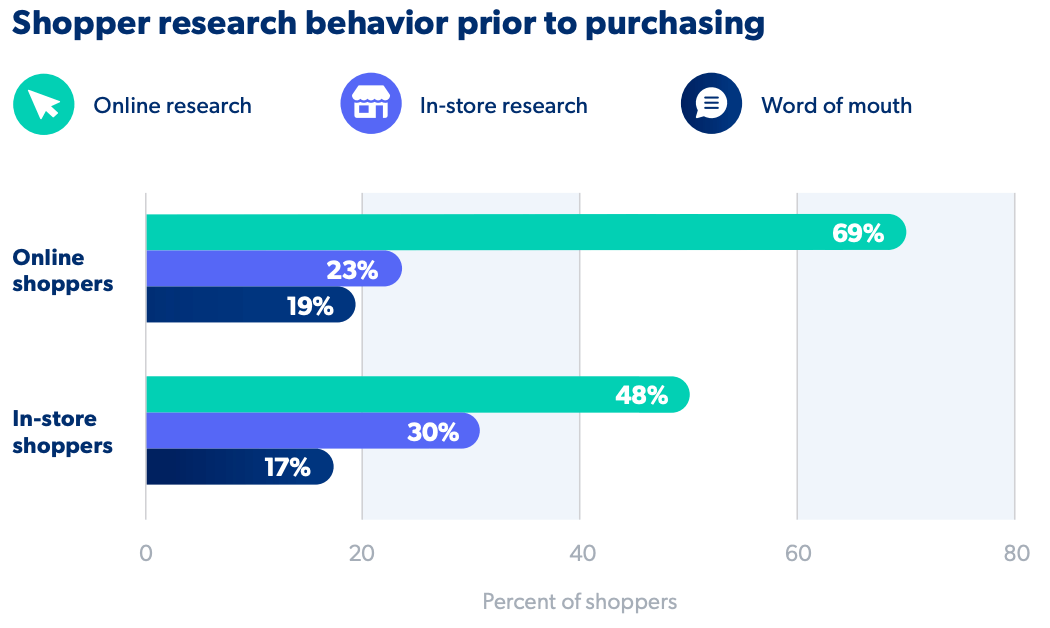
So how does the digital shelf unlock customer growth? Through two key aspects: visibility and credibility. Digital marketing, influencer marketing, retail partners, and ads make your brand more visible to your target audience. Then, by enhancing your brand’s credibility through ratings, reviews, and other user-generated content (UGC), you will inspire trust in your products and attract more customers.
Take Land O’Lakes as an example. By syndicating over 30,000 reviews to online retailers, the leading food company expanded its digital shelf space to drive sales and improve customer engagement and satisfaction. After distributing their reviews to other retail sites, they were able to reach customers where a majority of them prefer to shop and win their trust.
8 best practices for your omnichannel digital shelf strategy
If you want to stand out and win customers on the digital shelf, you need to provide an unparalleled shopping experience across all platforms. Let’s dive into the top eight tactics for building a successful omnichannel digital shelf.
1. Optimize product visibility in search results
Shoppers typically discover your digital shelf through a web search, so your brand needs to appear in search results to get in front of customers. Today, 64% of online shoppers use a search engine while researching products. If you’re not showing up on the first page of Google, then consumers probably won’t come across your brand.
When designing product pages, consider how search engines will find your website. Include relevant keywords in your product title and description, especially long-tail keywords, to capture more specific searches. But don’t go overboard and pack too many keywords on the page, or it will decrease the quality of your product copy. Balance is key.
For example, beauty brand Biossance tapped into the power of search engine optimization (SEO) to get in front of its customers. They identified keywords specific to their products, like ingredients, and integrated them into product names and descriptions. These pages are more likely to appear on the first page of search results for shoppers looking for rose oil or products with squalane or vitamin C.
2. Build user-generated content into the shopping experience
User-generated content helps customers build trust and confidence in their purchasing decision while they learn more about your products. In a 2021 survey of over 11,000 brands and retailers, customer engagement with UGC was linked to:
- 144% lift in conversions
- 162% increase in revenue per visitor
- 13% increase in average order value
E-commerce tools display visual and social content from Instagram, Facebook, Twitter, Pinterest, TikTok, and more on your product pages. By showcasing content created by real customers, your brand gives potential buyers a chance to get authentic feedback from people they trust.
Global fashion brand River Island is a prime example of how to turn UGC into a tool for revenue growth. The brand sources images of its customers wearing their clothes from social media to put social content at the forefront of its marketing campaigns.
After featuring inspiring visual UGC from social media on their homepage and product pages, River Island saw conversions increase by 184%. Their product pages also include a “Shop the look” feature that enables customers to add specific items in UGC to their wish list and create a more seamless shopping experience.
3. Regularly update product descriptions based on customer feedback
By proactively listening to customer feedback, you’ll improve your product pages before customers complain, request returns, or decide not to buy.
Ratings and reviews help you learn what features customers love most or how to improve a product. Plus, customer questions & answers enable you to identify communication gaps between your brand and your customers.
To incorporate customer feedback onto your product pages, comb through UGC — like photos, reviews, and customer Q&As — for valuable insights into what customers like, dislike, or don’t know about your products. Then adjust your product descriptions accordingly. Say lots of reviews mention how easy to use your product is. That’s a great feature to highlight in your product copy and images.
And if you’re soft launching a new product, customer feedback can also help you fine-tune it before its official release.
Lemi Shine, a family-owned manufacturer of household cleaning products, dove into their customer feedback after sending samples to its Club Clean Freak sampling community. After analyzing the reviews, they were able to adjust messaging and even change products before the public launch to deliver the information and value that shoppers wanted.
4. Use multiple avenues to collect ratings and reviews
Ratings and reviews bolster your brand’s digital shelf presence and consumer trust, but convincing customers to submit feedback can be challenging.
According to 66% of survey respondents, shoppers trust consumer reviews more than other formats like social and paid search ads. That’s because ratings and reviews feature current, authentic content from real users, which helps customers feel confident about their purchases.
So how can you collect as many of these invaluable reviews as possible? Don’t just wait and hope inspiration will strike and a customer will write a review months after their purchase. Leverage multiple communications channels to request reviews, such as:
- General email requests: Schedule automated emails between 14 and 21 days after purchase to thank customers for their orders and ask for feedback
- Review request emails: Invite customers to post reviews on your website after purchasing a product, registering a product warranty, or subscribing to your newsletter
- Product packaging: Include calls for reviews on product packaging or inserts, and consider offering a small discount on their next purchase to add more incentive for customers
- Social media giveaways: Create a social media hashtag campaign where people share UGC online for the chance to win free products
- Sampling programs: Get authentic feedback by sending free product samples to your most loyal customers in exchange for honest reviews
The apparel brand MeUndies overhauled its review collection strategy to increase review volume and engagement for new product launches. From adding a simple “Write a Review” button to product pages to sending follow-up review requests to customers who hadn’t responded to the first email, MeUndies saw a 218% increase in review collection. Over a third of those reviews came from follow-up review requests.
5. Invest in social commerce tools
Social commerce enables your brand to reach new customers and supports the delivery of a seamless shopping experience. Over half of shoppers say they’re more likely to buy a product on social media if they can click the post and get product info directly from their favorite platform.
To maximize your social channels’ impact on your digital shelf, turn your social media into a shoppable storefront to leverage UGC and drive traffic and revenue. Like2Buy is the leading social commerce solution that transforms your Instagram feed into a sales channel so your followers can read your blog, browse products, make purchases, and more.
Urban Barn, a furniture and décor company, leveraged UGC across social media platforms to push traffic to their website. Consumers were redirected to Urban Barn’s website, where they could shop their favorites from the brand’s Instagram feed, resulting in a 59% lift in conversion and a 29% increase in average order value.
6. Be strategic about special offers and online promotions
Not all promotions and special offers are made equal. While one-time deals and promotions will help you win new customers, recurring or future discounts will ensure they come back over and over again. When designing your promotional campaigns to maximize their impact, keep your customer segments in mind.
Each type of online promotion offers unique benefits to attract specific customers. Here’s some special offers to consider when building your digital shelf strategy:
- Dollar and quantity threshold deals: Win more new customers by offering them more bang for their buck
- New customer deals: First-time customer discounts will convince hesitant shoppers to make a purchase they would have otherwise abandoned
- Discount on next purchase: Once a customer has completed their purchase, entice them to shop with you again with a coupon for their next order
- Subscription discounts: Offer a small discount for recurring orders to nurture brand loyalty in new and returning customers
Amazon Subscribe & Save leads the pack when it comes to growing revenue through recurring subscription orders. One subscription results in a discount of up to 10%, while customers who add five or more eligible items to their subscription save 15%. The e-commerce giant unlocked new suggestive selling opportunities to drive sales through the combination of convenience and savings.
7. Create a sampling program for upcoming product releases
Let a small, controlled group test your new products before releasing them to a broader audience. A sampling program enables you to launch new products with reviews on day one and expand your digital shelf. Samples can also help you uncover potential problems and tweak your product or messaging before new items hit a wider market.
To launch a product sampling campaign, offer samples to your most loyal customers in exchange for reviews to boost review volume before publicly launching new products. By offering free products to customers, you’ll encourage them to post a positive review on social media as a thank you for the sample. Of course, this doesn’t guarantee positive reviews, but even negative reviews will add authenticity to your brand.
Burt’s Bees, a leading provider of natural health and beauty care products, leveraged its customer loyalty program, Hive Helpers, in an early launch of its new cosmetics category. Only two weeks after Burt’s Bees sent pre-released products to customers, 94% of those who received a sample submitted a review, resulting in over 300 reviews with a 4.48 average star rating.
8. Leverage the power of retail media networks
By advertising on a retail media network (RMN), your brand shows up on an online retailer’s digital shelf, further increasing your visibility to shoppers. RMNs expand your digital shelf across all the channels consumers use — from web and mobile to social media — while providing valuable first-party customer data to create highly personalized ads.
When partnering with a retail media network, start by syndicating your content to link reviews from your brand’s websites to your retail partners’ sites. Then incorporate this content in your retail ads to show why customers love your products and inspire trust in your brand.
The cybersecurity leader Webroot had a loyal customer base and many glowing reviews, but these reviews were limited to the brand’s native site. After syndicating reviews to retailers like Best Buy, Walmart, and Staples, Webroot’s review volume exploded by over 9,000%. The Webroot team also reached a response rate of nearly 100%, enabling them to quickly resolve any issues and retain customers.
Expand your brand’s digital shelf with user-generated content
Let’s be clear: a strong digital shelf requires strong, branded content. But to really unlock the full revenue potential of your digital shelf, lean on the people your customers trust the most: their fellow shoppers.
As more brands discover the value of user-generated content, even household names like Dole Packaged Foods are amplifying their customers’ perspectives to boost sales. After building a UGC program from scratch, Dole saw 2.3k new reviews and a 64% increase in conversions among shoppers who engaged with UGC.

The right end-to-end user-generated content platform can manage all aspects of your digital shelf strategy for you, from building brand awareness to increasing sales, and all the way to customer analysis.
To understand UGC’s impact on your brand’s revenue, conversion rate, and online and in-store sales, try our free UGC Value Calculator.

